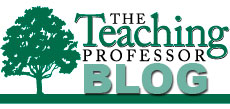Most of the time research evidence grows by bits and pieces—not all at once, and the evidence documenting the effectiveness of learner-centered approaches is no exception. It continues to accumulate, as illustrated by this study. It occurred in a third-year pharmacotherapy course in a doctor of pharmacy program. The students were randomly assigned to five- and six-member groups, with each group being assigned a patient case with multiple drug-related problems.
Read more ›CURRENT ARTICLE • July 15
OTHER RECENT ARTICLES
“Few teachers effectively prepare students to learn on their own. Students are seldom given choices regarding academic tasks to pursue, methods for carrying out complex assignments or study partners. Few teachers encourage students to establish specific goals for their academic work or teach explicit study strategies. Also, students are rarely asked to self-evaluate their work or estimate their competence on new tasks.” (p. 69)
Read More ›An intense couple of days at this year’s Teaching Professor Conference inspired me to revamp my course, and I’m starting at the very beginning. My goal is to set the perfect tone to inspire and engage as soon as students walk through my door. I’m taking the Dale Carnegie approach to people and applying that to the classroom. “There is only one way under high heaven to get anybody to do anything,” Carnegie writes. “Just one way. And that is by making the other person want to do it.”
Read More ›As we mentioned in the June 28 and July 5 posts, during the opening keynote at The Teaching Professor Conference, Elizabeth F. Barkley, a professor at Foothill College and author of Student Engagement Techniques: A Handbook for College Faculty (Jossey-Bass, 2010) presented on a topic she titled Terms of Engagement: Understanding and Promoting Student Engagement in Today’s College Classroom.
Read More ›It is only a slight exaggeration to say that resistance to educational assessment comes from almost as many different sources as there are assessment tools, but in the end the reasons usually all boil down to three main issues:
Read More ›Storytelling is the oldest form of education. The cave dwellers first taught their children lessons through stories. The Greeks picked up on the tradition by teaching morality through the myths.
Read More › Two faculty researchers assembled a large collection of syllabi from introductory courses in their field and then analyzed them to see how much active learning it looked like the teacher would be including in those classes. It’s a really neat research design which I explain in the next issue of The Teaching Professor newsletter. They also looked how much participation and in-class discussion counted in the total grade calculation and that’s what I want to write about in this post.
Two faculty researchers assembled a large collection of syllabi from introductory courses in their field and then analyzed them to see how much active learning it looked like the teacher would be including in those classes. It’s a really neat research design which I explain in the next issue of The Teaching Professor newsletter. They also looked how much participation and in-class discussion counted in the total grade calculation and that’s what I want to write about in this post.
Much of what passes for an “online course” these days could more accurately be described as the electronic version of class hand-outs. These courses usually consist of a course description, a syllabus, lecture notes, reading lists, and assignment checklists. In other words, whatever materials a student might have viewed on paper in the past are now read onscreen, and whatever presentations a student might have watched in the classroom are now observed on their screen.
Read More ›As we mentioned in the June 28 post, during the opening keynote at The Teaching Professor Conference, Elizabeth F. Barkley, a professor at Foothill College and author of Student Engagement Techniques: A Handbook for College Faculty (Jossey-Bass, 2010) presented on a topic she titled Terms of Engagement: Understanding and Promoting Student Engagement in Today’s College Classroom.
Read More ›If you read this blog regularly, you know that one of my concerns is the divide between research and practice, and our need to build bridges between the two.
Read More ›





